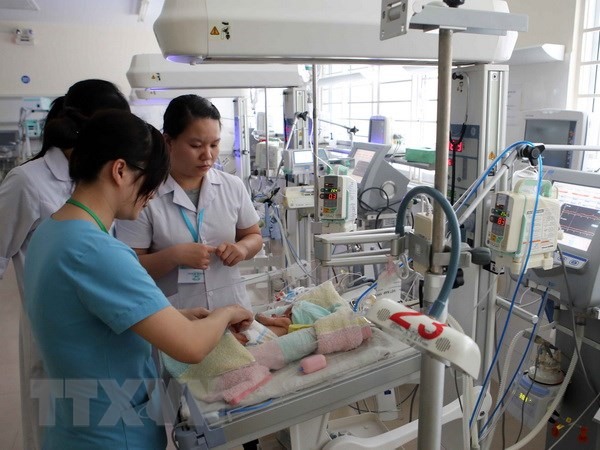 Society
Society

Maternal and child mortality rates could be reduced in Việt Nam if hospitals actively seek solutions to prevent medically adverse events and medical errors, the Maternal and Child Health Department of the Ministry of Health has recommended.
 |
| A newborn is treated at the Đà Nẵng Hospital for Women and Children in Đà Nẵng City. —VNA/VNS Photo Trần Lê Lâm |
HCM CITY — Maternal and child mortality rates could be reduced in Việt Nam if hospitals actively seek solutions to prevent medically adverse events and medical errors, the Maternal and Child Health Department of the Ministry of Health has recommended.
When a medically adverse event occurs, necessary steps that could solve the problem should be taken, Nguyễn Đức Vinh, the department’s head, said at a healthcare conference held in HCM City yesterday (August 21).
“Maternal and neonatal mortality is unavoidable, but it is very important that health officials seek methods to solve medical errors to reduce the mortality rate,” Vinh said.
Medically adverse events are defined as an injury caused by medical management rather than by the underlying disease or condition of the patient, according to the Florida State University College of Medicine’s website.
According to the department’s statistics, 134 medically adverse events were reported between 2016 and 2018. Of these, 45 caused maternal mortalities and 16 neonatal mortalities.
Vinh blamed the problem on overcrowding of patients at hospitals, and lack of compliance with professional regulations issued by hospitals and the Ministry of Health.
The poor capacity of health officials is another problem, he added.
In many provinces, for instance, doctors have failed to detect abnormal signs while examining pregnant women, and several women have been treated for abnormal signs when there were none.
Potential signs of postpartum haemorrhage, uterine rupture and hypertension have also not been detected in time.
Dr Nguyễn Bá Mỹ Nhi, deputy director of Từ Dũ Obstetrics Hospital, told Việt Nam News that postpartum haemorrhage, puerperal eclampsia, uterine rupture and puerperal sepsis are the leading causes of maternal mortality in Việt Nam.
Hospitals throughout the country continue to see a large number of patients.
Từ Dũ Hospital, for instance, last year admitted 400 patients with postpartum haemorrhage caused by placenta accreta, which was abnormally attached to the inside of the uterus. The figure had increased from 130 in 2013.
Nhi blamed the increase on the increasing number of C-section operations.
Another leading cause of maternal mortality is puerperal sepsis, although the complication can be treated with antibiotics. However, multiple antibiotic resistance is at a high level in Việt Nam compared to other countries.
The hospital admits 70,000 pregnant women for delivery every year, Nhi said, adding that more than 40 per cent of them have a C-section.
“The rate for C-sections is high. During surgery, there is potential for a medically adverse event,” she added.
Staff shortage
Dr Lê Nguyễn Nhật Trung of the city’s Paediatrics Hospital 2 said that doctors at the hospital and others in the city have provided professional training for hospitals in the southern and central regions, and the Central Highlands.
The quality of treatment, however, in these regions has not improved because of the shortage of doctors, nurses and equipment.
Gia Lai Paediatrics Hospital has 40 beds, and five doctors and nine nurses who provide neonatal health care services, but the province has 15,000 births a year.
The hospital also does not have sufficient equipment to meet demand, Trung said.
Kon Tum General Hospital has only one doctor specialising in neonatal care, which is one of the causes for medically adverse events, he said.
At Đắk Lắk Province’s General Hospital, rooms are narrow and damp so it is difficult to control hospital-acquired infections.
Every year, the hospital has more than 140 newborns who die and nearly 150 cases are transferred to hospitals for treatment in the city.
Dr Nguyễn Kiến Mậu of the city’s Paediatrics Hospital 1 said that nearly 80 per cent of newborns who died at the hospital had been transferred from provincial-level hospitals.
Nhi of Từ Dũ Hospital said that unsafe transfer from other hospitals had also occurred, resulting in injury or fatality.
Solutions
Trung suggested that hospitals in provinces should recruit more doctors and nurses, as well as buy new medical equipment.
To reduce medical adverse events, Từ Dũ Hospital has created a management process for them, according to Nhi.
“When an event occurs, the hospital’s managers and staff have to question why, how and what, so they can seek solutions,” she added.
Moreover, managers of the hospital should encourage staff and doctors to speak up and report medically adverse events so they can arrive at the proper solutions.
In the past, no doctor had reported such adverse events, but last year, 40 per cent of the hospital’s doctors did so.
“Mistakes are stepping stones to success,” Nhi added.
Like Từ Dũ Hospital staff, Paediatrics Hospital 2 staff also reports adverse events online and sends documents to the hospital’s managers every day if such events occur.
In addition, the hospital frequently opens training courses to improve staff capacity and healthcare quality.
More investment in modern equipment is considered one of the solutions to curb the number of medically adverse events, according to the hospital.
Moreover, the attitude of health staff toward patients and communication with patients and their relatives about health problems needs to be improved. — VNS




